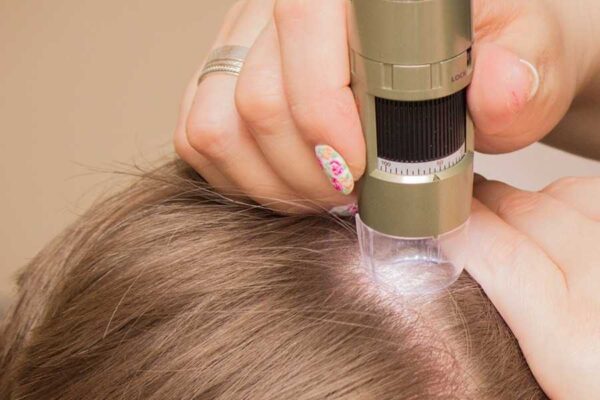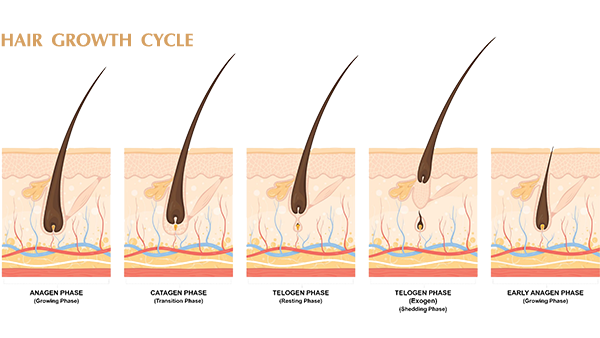Hair Loss Causes in Men & Women
Understanding Hair Loss & Thinning Hair in Men & Women
Understanding Hair Loss Causes:
Why Am I Losing My Hair?
What is the primary cause of hair loss among both genders? The most prevalent type of hair loss in both men and women is androgenetic alopecia or hereditary genetic hair loss. Approximately 80% of men and 50% of women experience this form of hair loss.

- Which vitamin deficiencies are linked to hair loss? Hair loss has been linked to deficiencies in several specific vitamins, including riboflavin (Vitamin B2), biotin, folate, and vitamin B12. Riboflavin is particularly crucial as it helps form flavin mononucleotide (FMN) and flavin adenine dinucleotide (FAD), both vital coenzymes.
- What is the leading cause of baldness? Genetics play the most significant role in hair loss, particularly through male-pattern baldness and female-pattern baldness. Unfortunately, this type of hair loss is genetic and cannot be prevented.
- What treatments can help a 70-year-old woman manage hair loss? For older women experiencing female-pattern baldness, a hair lotion containing minoxidil has proven effective. Many women report a reduction in hair loss and even a thickening of hair after regular use of this treatment.
Hormonal and Medical Conditions
Hormonal Changes: Events such as pregnancy, childbirth, and menopause can significantly influence hair loss due to the hormonal changes involved. Similarly, thyroid malfunctions, both hyperthyroidism and hypothyroidism, disrupt hormone levels, contributing to hair shedding.
Medical Conditions: Several medical issues lead to hair loss. Alopecia areata involves the immune system attacking hair follicles, resulting in sudden hair loss. Scalp infections like ringworm can invade the hair and skin of the scalp, leading to scaly patches and hair loss. Another condition, trichotillomania, involves a compulsive urge to pull out one’s hair.
Medications and Treatments
- Prescription Medications: Drugs used for cancer, arthritis, depression, heart problems, and high blood pressure have side effects that may include hair loss.
- Radiation Therapy: Particularly when administered to the head, radiation therapy can cause hair not to regrow in the same way it did previously, sometimes resulting in permanent alteration of hair texture or density.
- Supplements: Overuse or certain types of supplements can also lead to hair loss, highlighting the importance of balanced, monitored intake.
Physical and Emotional Stress
- Severe Stress Events: Physical or emotional shocks can disrupt the hair growth cycle, typically leading to temporary hair thinning known as telogen effluvium. This condition often resolves itself but can be triggered by events like major surgery, severe illness, or significant emotional stress.
- Hairstyles and Treatments: Excessive styling or hairstyles that pull tightly on the roots, such as pigtails or cornrows, can cause traction alopecia, a form of gradual hair loss. Additionally, harsh chemicals and heat treatments used in hair styling can weaken hair shafts, leading to breakage and loss.
Common Types of Hair Loss
- Androgenetic Alopecia: Also known as male-pattern baldness, this type is characterized by the thinning of hair in a distinct pattern and is influenced by hormones and genetic predisposition.
- Telogen Effluvium: A temporary hair loss typically triggered by stress, shock, or a traumatic event which causes hair roots to be pushed prematurely into the resting state.
- Alopecia Areata: An autoimmune disorder that causes sudden hair loss that appears as smooth, roundish bald patches on the scalp.
Traction Alopecia: Hair loss caused by pulling force being applied to the hair, commonly due to certain hairstyles that pull the hair tight. - Medically Related Hair Loss: Rapid hair loss due to chemotherapy is a common side effect faced by cancer patients.
The Progression of Hair Loss
- Stage 1: Hair begins to thin predominantly around the temples and the crown of the head.
- Stage 2: Gradual increase in the width of the hair parting and further thinning around the temples.
- Stage 3: Visible scalp with a significant loss of hair density, especially on the top of the head.
These diagnostic tools and understanding of hair loss types are crucial for effective treatment planning and management of expectations for individuals experiencing hair loss.
Genetic Factors Affecting Hair Loss
Androgenetic Alopecia and Hormonal Influence:
Androgenetic alopecia, often recognized as male-pattern baldness or female-pattern baldness, is primarily driven by genetic predispositions and hormonal factors. The enzyme 5-alpha reductase and its interaction with dihydrotestosterone (DHT) play critical roles in this condition. These elements contribute to the thinning of hair in a pattern that is often predictable once the condition has been diagnosed.
Genetic Predisposition in Men and Women:
Research indicates that genetic factors are responsible for approximately 80% of male pattern baldness (MPB) and about 50% of female pattern baldness (FPB) by the age of 80. The AR gene, located on the X chromosome, is a significant genetic marker in MPB, doubling the risk of hair loss in men possessing this gene. In females, the role of genes related to the enzyme aromatase, which converts testosterone to estradiol, is noted but not fully understood.
Inheritance Patterns and Misconceptions:
Contrary to the widespread belief that baldness genes are inherited solely from the maternal side, evidence suggests that these genes come from both parents. The inheritance of the baldness gene is complex and polygenic, meaning it involves multiple genes. This complexity adds to the variability and predictability of pattern baldness among individuals.

Androgenetic Alopecia
Androgenetic alopecia, commonly known as male-pattern baldness or female-pattern baldness, is primarily influenced by genetics and hormonal changes. This condition is characterized by a genetically determined shortening of the anagen phase—the active growth phase of hair follicles—and a prolonged interval before the commencement of a new anagen phase. This disruption leads to the gradual thinning and reduction of hair follicle size, known as follicular miniaturization.
The pattern of Androgenetic Alopecia hair loss differs significantly between men and women. In men, the hair loss typically begins above the temples, progressing to the crown and the frontotemporal regions, often leading to complete baldness in severe cases. Conversely, women usually experience a diffuse thinning of hair across the crown and top of the head while the frontal hairline remains largely unaffected. This distinct pattern in women leads to widespread thinning without complete baldness.
The progression of androgenetic alopecia is closely associated with the activity of dihydrotestosterone (DHT), a potent androgen hormone. Increased levels of DHT in both men and women, heightened activity of the enzyme 5 alpha-reductase, and a greater number of androgen receptors in scalp areas prone to hair loss exacerbate follicular miniaturization. Treatments target these hormonal pathways to slow hair loss and stimulate regrowth. Options include topical Minoxidil, which is effective for both genders, and oral Finasteride, which is specifically approved for men due to its mechanism of reducing DHT levels.
Telogen Effluvium
Telogen effluvium is a form of hair loss triggered by a disruption in the natural growth cycle of hair, particularly after the body experiences significant stress to the central nervous system or other significant change. This condition predominantly affects the telogen phase, where hair follicles remain dormant before eventually shedding. Typically, telogen effluvium manifests itself as a noticeable thinning of hair across the top of the scalp.
Topical Treatment Options
- Minoxidil (Rogaine): This over-the-counter medication is widely used to slow hair loss and promote regrowth. It is applicable for both men and women and is typically applied topically twice daily.
- Finasteride (Propecia, Proscar): Available by prescription, Finasteride is particularly effective in men, reducing hair loss by inhibiting the production of dihydrotestosterone (DHT), a hormone implicated in androgenetic alopecia.
- Corticosteroids: These are used for treating alopecia areata and other conditions where the immune system attacks hair follicles. They can be administered through local injections, topical ointment application, or orally under the guidance of your doctor or dermatologist
You should immediately consult with your doctor if you experience sudden or unusual hair loss, patchy hair loss, scalp abnormalities such as redness, flaking, or scarring.
Surgical Hair Restoration Options
Hair transplant surgery involves transferring hair from denser areas of the scalp, or other parts of the body, to the balding or thinning areas. This technique is highly effective for long-term results for men and women experiencing hereditary hair loss (androgenetic alopecia), as well as other types of hair loss.
Topical Treatments for Hair Loss
- Minoxidil (Rogaine): This topical treatment is applied directly to the scalp and is effective for both men and women. It functions by prolonging the growth phase of hair follicles, thus reducing hair loss and encouraging new growth.
- Finasteride (Propecia, Proscar): Primarily prescribed for men only, this oral medication decreases the production of dihydrotestosterone (DHT), a hormone that contributes significantly to hair loss. Continuous use is required, as stopping the medication can reverse its effects.
When considering hair loss solutions, it is very important to consult with your doctor, your dermatologist or a qualified hair loss treatment specialist.
Non-Surgical Hair Loss Solutions
- Low-Level Laser Therapy (LLLT): Utilizes specific light wavelengths to stimulate hair follicles, enhancing cell metabolism and improving blood circulation in the scalp.
- Non-surgical Hair Replacement: Non-surgical hair replacement systems offer a range of advantages for individuals seeking to restore their hair. One of the key advantages is the natural appearance that today’s modern hair systems provide, allowing individuals to confidently go about their daily activities without the worry of their hair replacement being noticeable or artificial looking. A non-invasive option, hair replacement offers a popular and convenient choice for those have insufficient hair for transplantation, or who are looking to regain a full head of hair.
Lexington Hair Restoration Specialists
Understanding the causes, signs, and proven treatments for hair loss can help empower you to take control of your hair loss. Whether you choose non-surgical solutions, such as topical hair loss treatments and laser hair therapy, opt for a custom non-surgical hair replacement system, or choose hair transplant surgery, there are options available to suit your needs and preferences.
Take the next step! Let us help you understand your options. Our experienced team will help you find the right plan for your hair. Make an appointment for a COMPLIMENTARY CONSULTATION today!
Disclaimer: Individual results may vary. Information on this website is provided for educational and informational purposes only and does not constitute providing medical advice or professional services. The information provided should not be used for diagnosing or treating a health problem or disease, and those seeking personal medical advice should consult with a licensed physician. Always seek the advice of your doctor or other qualified health provider regarding a medical condition. Never disregard professional medical advice or delay in seeking it because of something you have read on this website.
